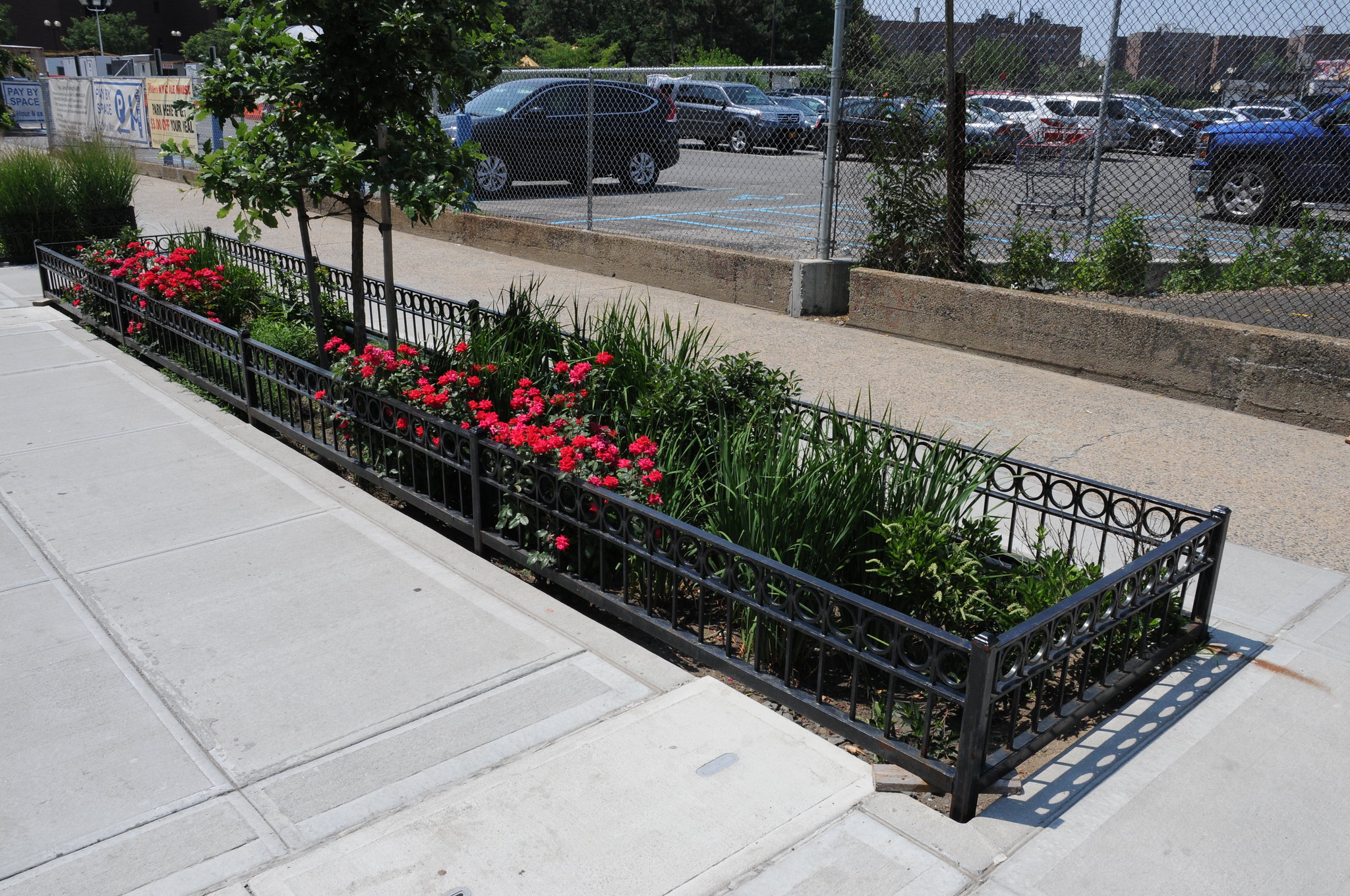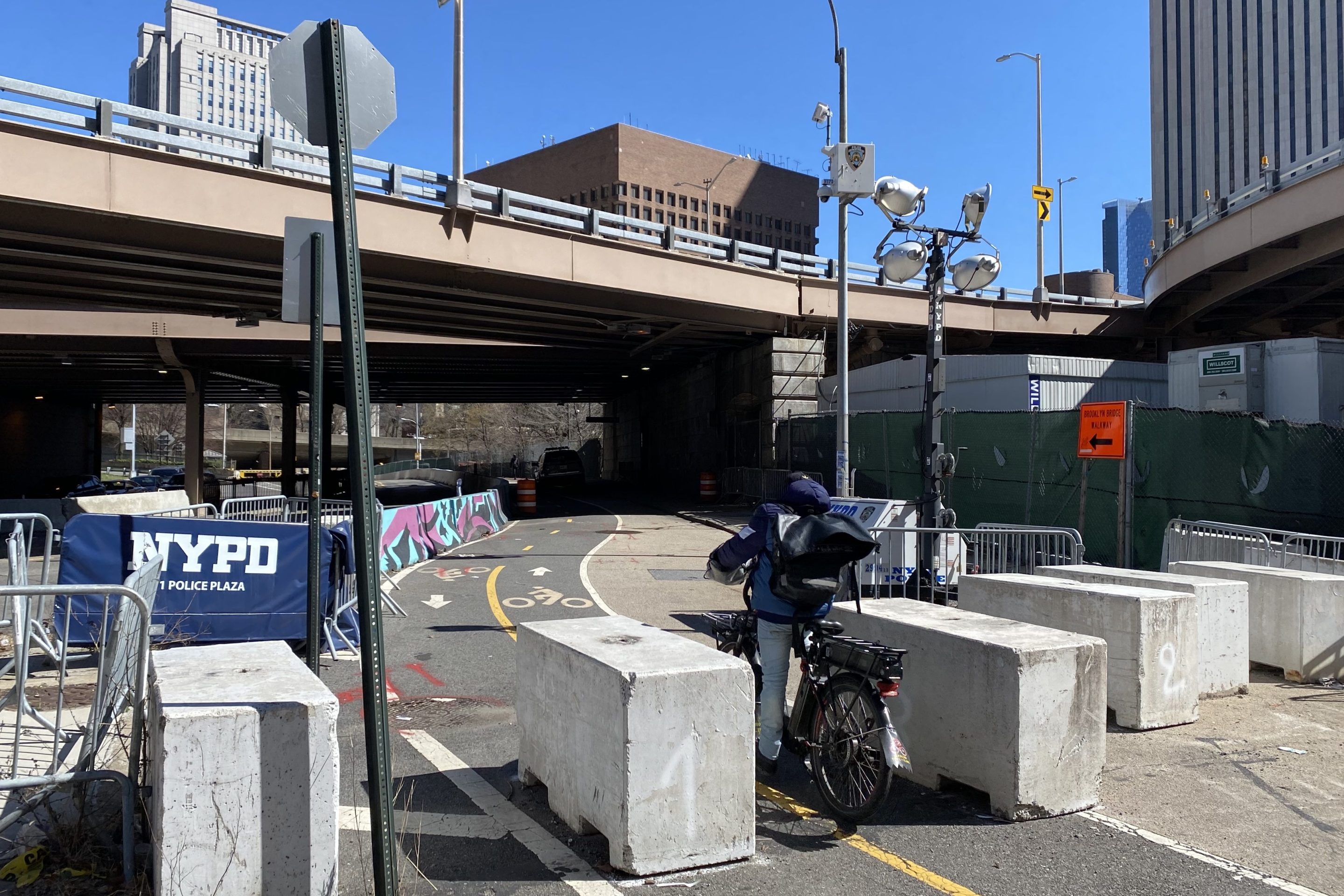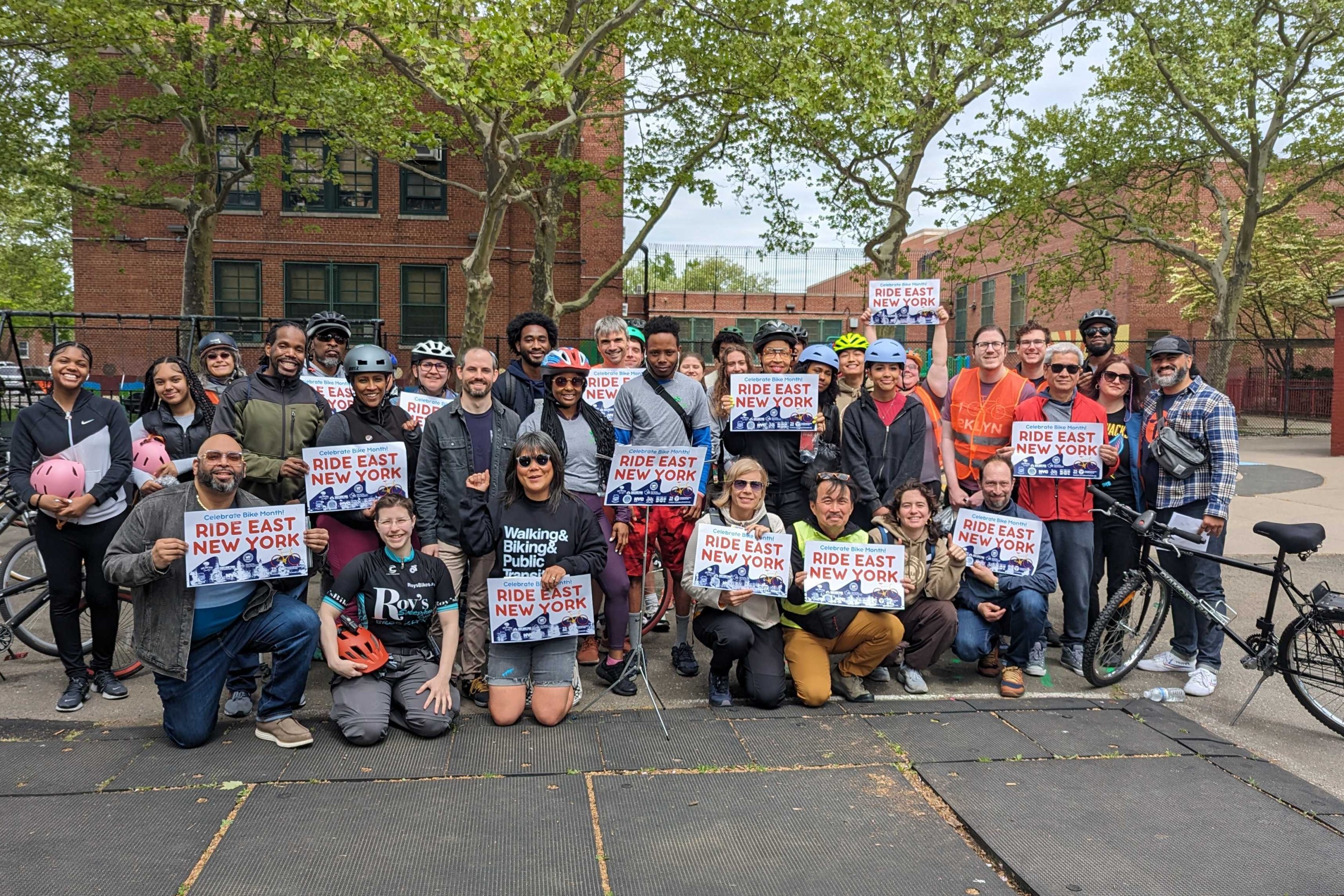Please Stay On The Grass: More Absorbent Streets Could Mean Less Catastrophically Flooded Subways
9:45 AM EDT on September 3, 2021

A curbside rain garden in Queens. Photo: NYC DEP
A combination of New York's new subtropical climate and the fact that most subway stations are underground means that the flash flood scenes like those seen in the summer of 2021 aren't ever going to completely go away. But as we enter a bold new era of ruinstorms, experts say the city and the MTA can at least work on mitigating the worst of the floods by going green. Literally.
"In a lot of ways the MTA and its infrastructure is the last line of defense," said TransitCenter Communications Director Ben Fried. "When you get to the city level this is a problem that affects more than just the subway, and mitigation is going to involve a lot more than subway infrastructure. So it's really incumbent on the city to get creative and ambitious about creating more permeable surfaces on the streets, this enormous, impermeable, right of way that it controls."
When the remnants of Hurricane Ida settled over New York and dumped three inches of rain on parts of the city in just an hour, it did more than shatter the hourly rainfall record set on the day of the city's ill-fated homecoming concert in Central Park. It also led to scenes of water gushing out of subway walls and running over tracks like log flumes, and stranded 1,000 subway riders across the city. Since on a normal day the MTA pumps 14 million gallons of water that seeps into the subway system every day, it's incumbent on the city to create streets and sidewalks that can actually absorb water.
"I'm not saying that we can prevent three inches of rainfall in an hour from causing any damage or harm, but we can prevent it from causing so much damage and so much harm. I think it's technically possible possibility, but we just have to make it a political reality," said Fried.
The subway can only handle rainfall of 1.75 inches per hour — an amount that used to be considered extremely rare, but isn’t anymore.
Remarkable detail about NYC infrastructure:
— The Honest Broker (@RogerPielkeJr) September 2, 2021
Sewer system designed to accommodate a 5-year storm, one with a 20% chance of occurring in any year
Like the Texas freeze, events are exposing poor infrastructure & limited capacity to deal with rare eventshttps://t.co/K6fJ9ShY1z pic.twitter.com/bENHFVqUif
The city also seems aware of how common these kinds of rainstorms are, at least according to the lawsuit the de Blasio administration filed against Big Oil in 2018. In a legal filing for the case, the city pointed out that "the number of days in New York City with rainfall at or above two inches is projected to increase by as much as 67% by the 2020s and the
number of days with rainfall at or above four inches is projected to increase by as much as 67% by the 2020s and 133% by the 2080s."
Not sure if you're joking, but here are some excerpts from that complaint. https://t.co/EK7Ctoa3SP pic.twitter.com/xDvMz3ax67
— Justin Gundlach (@JMGinNYC) September 3, 2021
Street design is a necessary, but neglected, weapon against flooding. In 2017 the National Association of City Transportation Officials published a comprehensive guide to creating storm-friendly streets through the use of things like street trees, bioswales and planters that manage excess stormwater. The city hasn't ignored the idea. As of 2020, it had installed over 660,000 square feet of pervious surfaces to sidewalks and streets according to the Department of Environmental Protection. But in a city with 6,300 miles of roadway, advocates are asking for a pace that matches the intensity of water falling from the sky.
"Our mayor controls 6,300 miles of streets and can immediately repurpose them for higher use, like stormwater management and other green infrastructure that mitigate the devastating impacts of climate change," said Transportation Alternatives Executive Director Danny Harris. "Our streets must be a pathway to recovery, and it’s time for our current and future elected officials to start treating them that way." (Reminder: the shift to electric cars, seen by many as the silver bullet for climate change, will do nothing to solve the "absorbency" question, since electric cars will require pavement just like today's cars.)
Our infrastructure is not ready for climate change, a thread from tonight. 28th St. subway station pic.twitter.com/uYemJKB8yg
— Brian Kahn (@blkahn) September 2, 2021
The political piece of the puzzle isn't simply a matter of finding the will to do something as ambitious as Transportation Alternatives' 25x25 plan, or as common sense as not storing drain-clogging garbage directly on the sidewalk so the trash has an easier path to blocking drains. City and state cooperation will also be a key factor in determining what happens next time something like Wednesday night's deluge overwhelms the city.
Marcel Negret, a senior researcher at the Regional Plan Association, recommended a series of steps the city and state could take to shore up the subway in July after flash flooding overwhelmed the system. Negret gave high marks to city efforts like the unified stormwater rule, which if implemented will require developers building on lots over 20,000 square feet to include flood mitigation aspects like stormwater retention systems or tanks that moderate the release of storm water into the sewer systems. But he also said the de Blasio administration's recent stormwater resiliency guide took a siloed view of the transit system that the city relies on without owning.
"Where I do think [the report] comes up short is how it treats transportation infrastructure," Negret said. "It doesn't mention the subway system a lot, and the section where it is mentioned, it's basically says it is the MTA's responsibility address a flash flood emergency. But that's not the smartest strategy or approach. Of course investments in pulling that water out of the stations once it's there needs to be part of the plan, but we should be preventing the water getting into the facilities in the first place."
WaPo has a MUCH clearer analysis than the multi-reporter NYT piece. Rip up the damn pavement! https://t.co/WY45NzvUEB
— Radlerkönigin (@radlerkoenigin) September 3, 2021
Underscoring the importance of city and MTA cooperation, Negret's July missive mapped the DEP's own moderate and extreme scenario flood maps on the subway map to see which stations were vulnerable to flooding during heavy rain. The extreme flood map, which looked at rates of 3.5 inches of rain per hour, showed that the 28th Street 1 stop, where water gushed out of a platform wall during Wednesday's floods, was one of almost 400 stations that could be impacted by continuous or nuisance flooding.
There are hints of an era of cooperation around flash flood mitigations though. Interim MTA Chairman and CEO Janno Lieber said one of his first actions when he sat in the big chair was to call the DEP and the transit agency.
"When I came in a couple of weeks ago, one of the first things I did was to establish an urgent collaboration with the city of New York's Department of Environmental Protection, which runs the sewer system and the drainage system, about how are we going to start to deal with this flash flooding problem, this problem that is emerging in the era of climate change," Lieber said at a press conference on Long Island on Thursday. "Today was a day we actually had scheduled a series of outings to do that."
And climate experts warn that we shouldn't be mollified when Ida's wrath is described as a "500-year storm." A 500-year storm means that each year there's a 0.2 percent chance seeing the kind of extreme storm that hit on Wednesday, according to Columbia University's Mona Hemmati.
"This percentage may increase in the future due to climate change as some studies have shown and we may have multiple events like what happened last night within just one year," said Hemmati, a post-doctoral research scientist at the Lamont-Doherty Earth Observatory, Earth Institute. "It's uncertain how often we are going to see such an event, but we expect to see these extremes more often. The bottom line is that climate change makes these extreme events more probable and intense as warmer atmosphere holds more moisture like a big sponge, and these numbers should be updated considering climate change."
Here are two videos from Streetfilms about how this is working elsewhere:
Montreal's planted curb extensions
Indianapolis's bioswales
Dave Colon is a reporter from Long Beach, a barrier island off of the coast of Long Island that you can bike to from the city. It’s a real nice ride. He’s previously been the editor of Brokelyn, a reporter at Gothamist, a freelance reporter and delivered freshly baked bread by bike. Dave is on Twitter as @davecolon. Email Dave Colon at dcolon@streetsblog.org
Read More:
Stay in touch
Sign up for our free newsletter
More from Streetsblog New York City
City Considers Fixes for Another Ridiculously Slow Cross-Bronx Bus
Potential bus improvements are on the table for the Bronx's Tremont Avenue, but the Adams administration's failures on nearby Fordham Road loom large.
DOT Unveils First Step for Park Row Redesign
The city hopes to make Park Row more appealing to residents and visitors. But the real work is years off.
Monday’s Headlines: East New York’s New Bikes Lanes Reduced Crashes Edition
Initial results show East New York's protected bike lanes made Cozine and Wortman avenues safer. Plus more news.
Stockholm Leader’s Message to NYC: ‘Congestion Pricing Just Works’
"In Stockholm, people really thought that congestion pricing would be the end of the world, the city will come to a standstill, no one would be able to get to work anymore and all the theaters and shops would just go bankrupt. None of that happened."
Friday’s Headlines: Trump Trial Trumps Safety Edition
Is anyone going to bother to fix the dangerous mess on the streets and plazas around the Trump trial? Plus more news.




